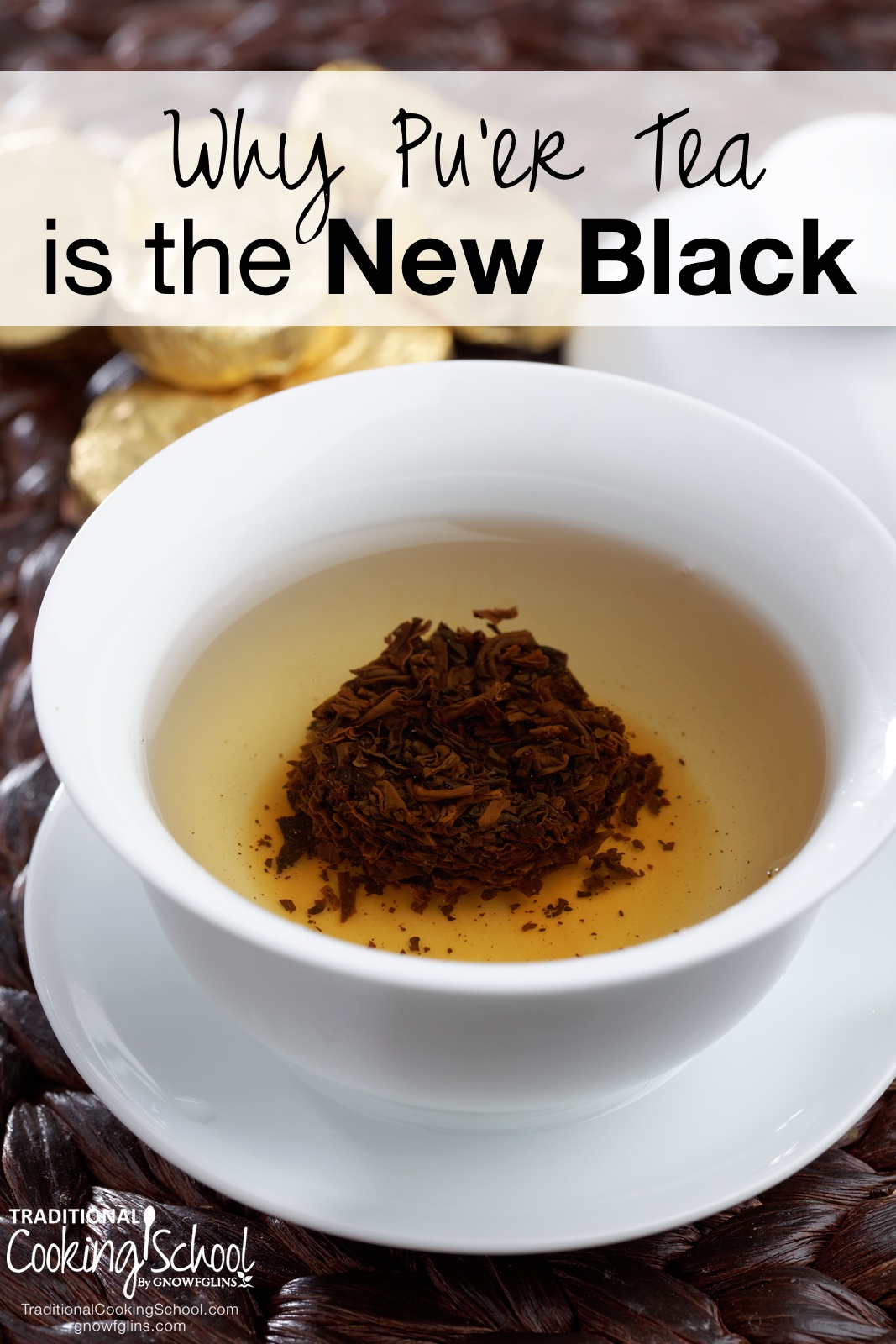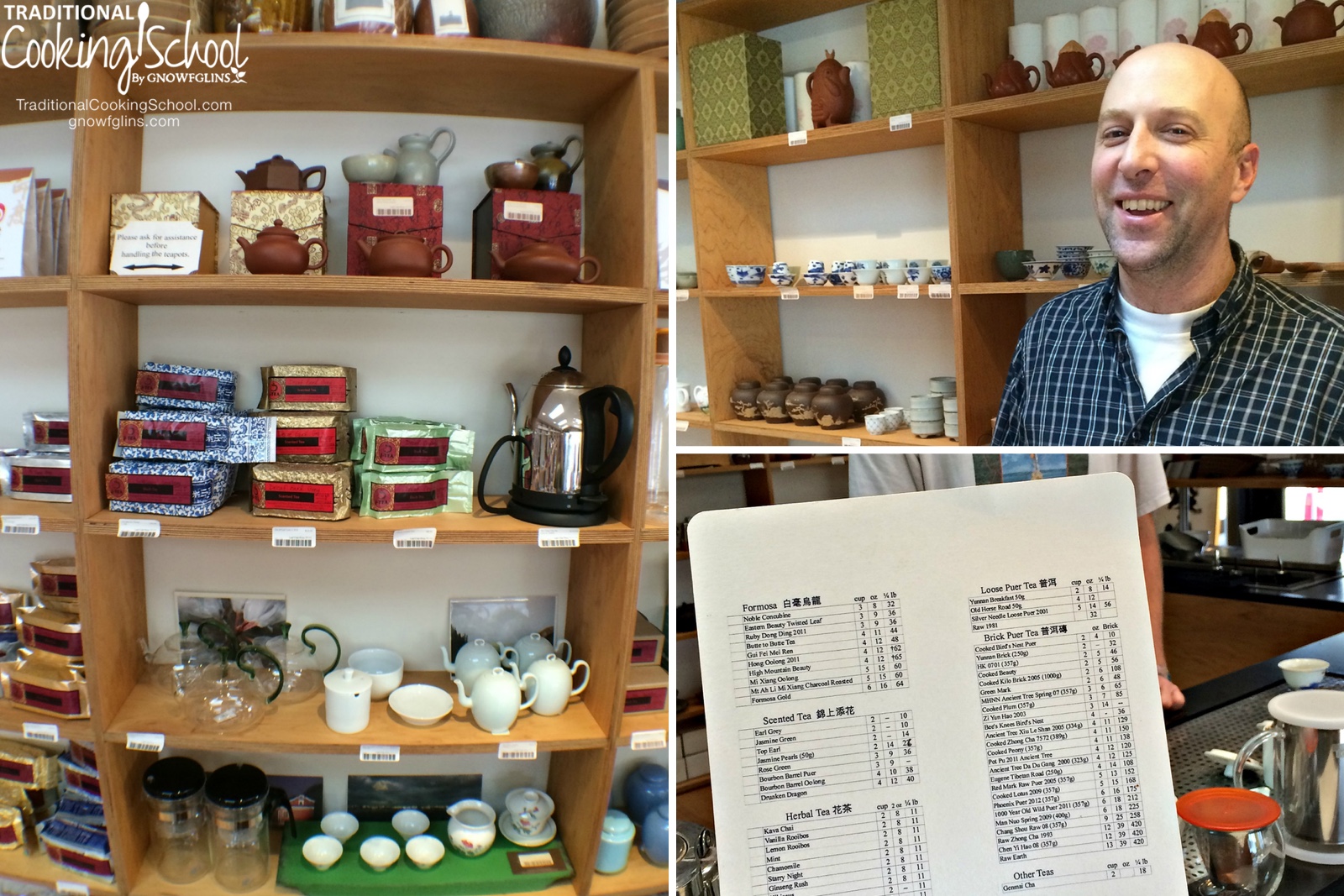
It’s the perfect cup of tea — echoing both green and black teas.
A semi-broad leaf, this revered, hand-harvested, and often expensive tea dates back to the ancient tea culture of China.
Have you ever heard of Pu’er tea?
To attract rather than repel potential buyers, the wise pu’er retailer knows how to balance the quality of product with its price tag.
Where I live in Eugene, Oregon, we have such a tea connoisseur — a man respected the world over for his knowledge of tea.
His little tea house, J-TEA, is charming, rich, and an educational experience.

Our J-TEA Experience
My husband and I sit at the bar, near where the beverage is prepared. The process is captivating.
The man making our tea uses the leaves twice, sometimes more often depending on their steeping time and concentration. He answers our questions as we sip, handing us teeny cups of new teas to try.
We take little gulps, breathing in air, and savor even the texture of each tea.
Our server is busy with other orders as well. We see him shake tea on ice, serve tea over jam, and pour tea over the outside of tea pots.
Yet, we have come to see pu’er.
What makes it unique? This is what Josh, the owner of J-TEA, says:
To hear Josh in greater detail and to watch him prepare our tea, watch the longer video here.
How to Make the Perfect Cup of Pu’er Tea
As with other teas, there are three variables that go into making the perfect cup of tea: time, temperature, and quantity. Each variable affects the other two.
Extra hot water, for instance, requires a shorter brewing time and less tea.
Less hot water — best when steeping green tea — requires a longer brewing time or more tea leaves.
With pu’er, more leaves are used as well as moderately hot water. Many brews are recommended in succession, with the same leaves.
For a small cup, use 1 to 2 teaspoons (5 to 8 grams) loose pu’er leaves.
Pour hot water over the leaves once to allow them to “wake up.” Drink or discard this first pouring. Pour fresh hot water over the uncurled leaves, and allow it to steep 2 to 3 minutes. Then drink.
Continue to pour hot water over the leaves, drinking the tea, until you personally feel they are done.
This subjective decision is traditional to pu’er cultures.
Because frugality is valued, it is not considered base or uncultured to drink what Americans might call “weak” tea.
And, frankly, the tea continues to give off valuable flavor for 10 to 12 steepings.
More Information About Pu’er
There are four kinds of pu’er:
- young raw
- old raw
- young cooked
- old cooked
Which is best? This answer is also subjective, based on each individual and the nuances of a particular collection of pu’er leaves.
Pu’er’s uniqueness is found in the nature of its aging and subtle ongoing oxidation in addition to its stage of harvest.
Leaves from many different batches may be combined to create a brand of tea. When a particular pu’er tea becomes popular, ironically it may never be exactly replicated.
If the tea traveled through a storm on the back of an elephant, for instance, how would one ever recreate the exact humidity and weather conditions responsible for its aging process?
The most common pu’ers available in the United States are cooked pu’ers.
During the process of “cooking”, heat is used to stop the main oxidation, but fermentation continues. The golden green leaves are transformed to mahogany-black.
Pu’er tea is packaged into many different shapes and sizes — all of them exposing the product to air so the distinctive aging of this tea continues.
I found the flavor of cooked pu’er tangier than raw pu’er, with an almost fishy or soy sauce quality. As I continued to sip, the initial impression went away and I liked it increasingly.
My favorite tea was an aged raw tea, light green in color but similar in taste to a delicate black tea. It had many nuances — even a provocative texture.
Surprisingly, I would not have dared to add cream or honey. It was deep and earthy and everything I could want in a tea, but more so, as if the tea was teaching me something new.
I can see why Josh, the owner of J-TEA, is passionate about pu’er. Each sip is an experience.
Have you had pu’er? Was it cooked or raw? I’d love to hear your impressions!
...without giving up the foods you love or spending all day in the kitchen!

2 free books:
Eat God's Way
Ditch the Standard American Diet, get healthier & happier, and save money on groceries...
We only recommend products and services we wholeheartedly endorse. This post may contain special links through which we earn a small commission if you make a purchase (though your price is the same).


thank you for posting this pu’er tea. it sounds like it could be a means to wake up instead of other hot drinks. the word fermentation is within the process. I am one that restrains from the use alcohol. my question: is there so much as a trace of alcohol in this pu’er tea?
There is no alcohol in pu’er tea. It has gone through an oxidation process that has some commonalities with fermentation, but is different. We can think of its oxidation process as an aging process. So, no alcohol.
I’ve had pu’er tea. Sent to me as a sample I have no idea if it was cooked or raw. I’d love to try it again. maybe i can find it online.
On a side note, fermentation that creates alcohol requires sugar. green leaves don’t have enough sugar in them to allow the creation of alcohol before they dry.
Shu Puerh can take a bit of time for some people to get used to so I often introduce two ways to enjoy it.
Small cup brew as above, or the same way you would drink a cup of coffee.
Brewing Puerh in a teapot (with a mesh basket) for 3-4 minutes, pour in a mug and add cream and sugar if you like. (In Winter I often add a small piece of cinnamon to the basket… grandkids like this!)
Puerh is warming in Winter and good for the stomach.
You can place spent (used) leaves in room temperature filtered water, then place in the refrigerator for refreshing iced Puerh.